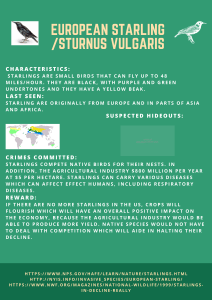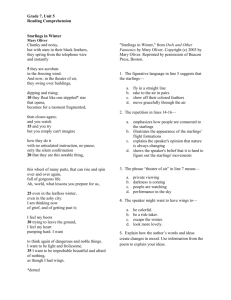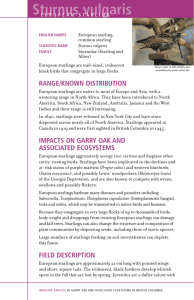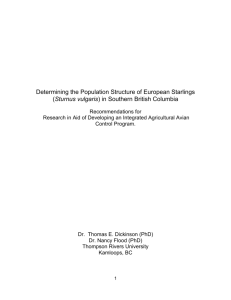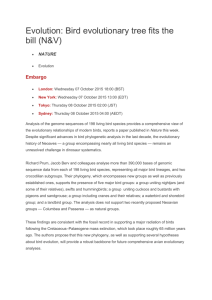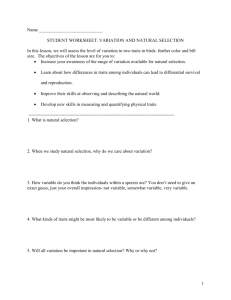Wlf 315 Wildlife Ecology Lab
advertisement
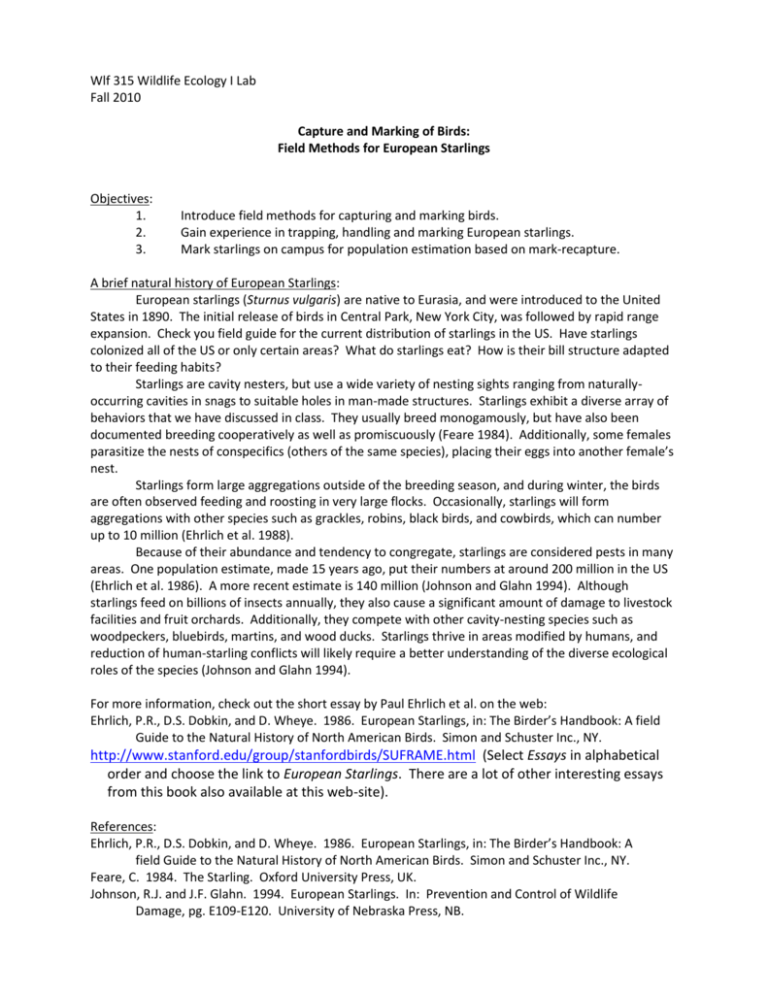
Wlf 315 Wildlife Ecology I Lab Fall 2010 Capture and Marking of Birds: Field Methods for European Starlings Objectives: 1. 2. 3. Introduce field methods for capturing and marking birds. Gain experience in trapping, handling and marking European starlings. Mark starlings on campus for population estimation based on mark-recapture. A brief natural history of European Starlings: European starlings (Sturnus vulgaris) are native to Eurasia, and were introduced to the United States in 1890. The initial release of birds in Central Park, New York City, was followed by rapid range expansion. Check you field guide for the current distribution of starlings in the US. Have starlings colonized all of the US or only certain areas? What do starlings eat? How is their bill structure adapted to their feeding habits? Starlings are cavity nesters, but use a wide variety of nesting sights ranging from naturallyoccurring cavities in snags to suitable holes in man-made structures. Starlings exhibit a diverse array of behaviors that we have discussed in class. They usually breed monogamously, but have also been documented breeding cooperatively as well as promiscuously (Feare 1984). Additionally, some females parasitize the nests of conspecifics (others of the same species), placing their eggs into another female’s nest. Starlings form large aggregations outside of the breeding season, and during winter, the birds are often observed feeding and roosting in very large flocks. Occasionally, starlings will form aggregations with other species such as grackles, robins, black birds, and cowbirds, which can number up to 10 million (Ehrlich et al. 1988). Because of their abundance and tendency to congregate, starlings are considered pests in many areas. One population estimate, made 15 years ago, put their numbers at around 200 million in the US (Ehrlich et al. 1986). A more recent estimate is 140 million (Johnson and Glahn 1994). Although starlings feed on billions of insects annually, they also cause a significant amount of damage to livestock facilities and fruit orchards. Additionally, they compete with other cavity-nesting species such as woodpeckers, bluebirds, martins, and wood ducks. Starlings thrive in areas modified by humans, and reduction of human-starling conflicts will likely require a better understanding of the diverse ecological roles of the species (Johnson and Glahn 1994). For more information, check out the short essay by Paul Ehrlich et al. on the web: Ehrlich, P.R., D.S. Dobkin, and D. Wheye. 1986. European Starlings, in: The Birder’s Handbook: A field Guide to the Natural History of North American Birds. Simon and Schuster Inc., NY. http://www.stanford.edu/group/stanfordbirds/SUFRAME.html (Select Essays in alphabetical order and choose the link to European Starlings. There are a lot of other interesting essays from this book also available at this web-site). References: Ehrlich, P.R., D.S. Dobkin, and D. Wheye. 1986. European Starlings, in: The Birder’s Handbook: A field Guide to the Natural History of North American Birds. Simon and Schuster Inc., NY. Feare, C. 1984. The Starling. Oxford University Press, UK. Johnson, R.J. and J.F. Glahn. 1994. European Starlings. In: Prevention and Control of Wildlife Damage, pg. E109-E120. University of Nebraska Press, NB. Lab Exercise: Trapping and Banding European Starlings (Sturnus vulgaris) Reading Assignments: 1. Ehrlich et al. (1986). Reference and web-page address above. 2. TBA – will be posted on the lab web-page. Exercise Expectations: 1. Participate actively in the field exercise. 2. Read assigned material and learn capture and marking procedures for birds. 3. Complete data sheets for all birds that your group traps and marks. 4. Collect all of the data from each of your group members and enter the data into an Excel file to be emailed to your TA (one per group). Make sure that everyone in your group has participated and that their names are associated with the data. Methods: 1. Form groups of three students. 2. Read this handout thoroughly and be sure you understand the methods before starting. Choose which student will accomplish each task. Rotate the duties with each capture. 3. Wear rubber gloves when handling the birds and be conscious about not touching your face until you have washed your hands with soap & water. 4. Capture an individual bird by hand or using the fish net, and secure the bird from behind with a gentle grip (we’ll go over the techniques for this in lab). 5. Identify the sex and age class carefully. Work together with your partners to complete and record the measurements. Techniques for sexing, aging, and measuring are below. 6. Place the aluminum number band around the bird’s right. Record sex and age class of each bird along with the band number. 5. Place the bird gently into the weighing tube, and attach the tube to the Pesola scale. Record the weight. Grasp the bird and remove the tube completely before releasing the bird on the ground. Make sure that people allow enough room for the bird to fly away. Cautions: 1. Be calm, confident, and speak quietly when working with the animals. 3. Keep the bird under control until you are ready to release it. Professionalism: When undertaking a study that involves capturing and marking wild animals, the reasons that necessitate handling the animals should be clearly defined, and potential negative effects of capture or marking should be considered. Any time an animal is handled, there is the risk of injury or death. Precautions should be taken to protect both the animals and people participating in the exercises. It is the responsibility of the wildlife professional to minimize the impact on animals and to ensure the safety of his or herself and others. Please be respectful of the birds and your classmates during this lab exercise. Data Recording: Record data for each trapping session on the data sheets. Record additional comments in the last column of the table. Such comments might include observations of anything that seems unusual about the animals, animal condition, interesting behaviors, or some trouble with a trap. If you capture a bird that has already been banded, record the band number, and then release the bird. Sexing and Aging Techniques: We are capturing the starlings after the breeding season when they have completed the fall molt into their winter plumage. Starlings occasionally raise 2 or 3 clutches and we may see differences in the degree to which young of the year have attained winter plumage. The bottom line is that it can be difficult to assign some individuals to age classes, so make sure you check each bird out carefully. Use multiple characteristics and ask for help if you are unsure about aging a bird you have in hand. Sex: Male: 1) Eye color is uniform dark brown. 2) Generally, fewer and smaller spots on breast. 3) Generally, more iridescence on head, nape, throat, breast, rump & undertail coverts (both sexes have iridescence on the wings and back). Female: 1) Eye has a lighter ring around either the inner or outer the edge of the iris. 2) Generally, more and larger spots on breast. 3) Generally, less iridescence on head, nape, throat, breast, rump & undertail coverts. Age: Immature (hatched this year): 1) May have some juvenile plumage remaining, which is brown/gray with a lighter throat and streaking on the underparts, and may have brown or grayish legs. 2) Generally, less glossy than adults and more spotted (female immatures may be difficult to distinguish). 3) More rounded tips to tail feathers (retrices) and less well-defined pale margins on the retrices. 4) Pale feather tips on the underside are not divided by a pointed extension of the dark part along the rachis as in adults. Length of iridescence on the throat: Male: < 10 mm = immature 10-12 mm = unknown > 12 mm = adult Female: < 6 mm = immature 6-7 mm = unknown >7 mm = adult Measuring Techniques: (see illustration) Collect the following measurements in millimeters using the calipers. You may want to practice first with the calipers to be sure that you are reading the scale correctly. WING: The straight-line length of the wing in a closed position from the bend (bird's wrist) to the tip of the longest primary (flight) feather. The curvature of the wing should NOT be flattened – maintain the camber. BILL: The length from the tip of the bill in a straight line to the base of the feathers on the forehead. TARSUS: The distance from the joint between the tibia and metatarsus to the base of the middle toe. WLF 315 2010 Starling Banding Lab Exercise Page ____ of ____ Lab Section: Mon or Tue Date:________________ Group Members: REMEMBER: Band on Bird’s Right Leg Band Number 1st capture or Recapture (C or R) Age Class (J or A) Wing Tarsus Bill Weight w/tube Tube weight Comments
